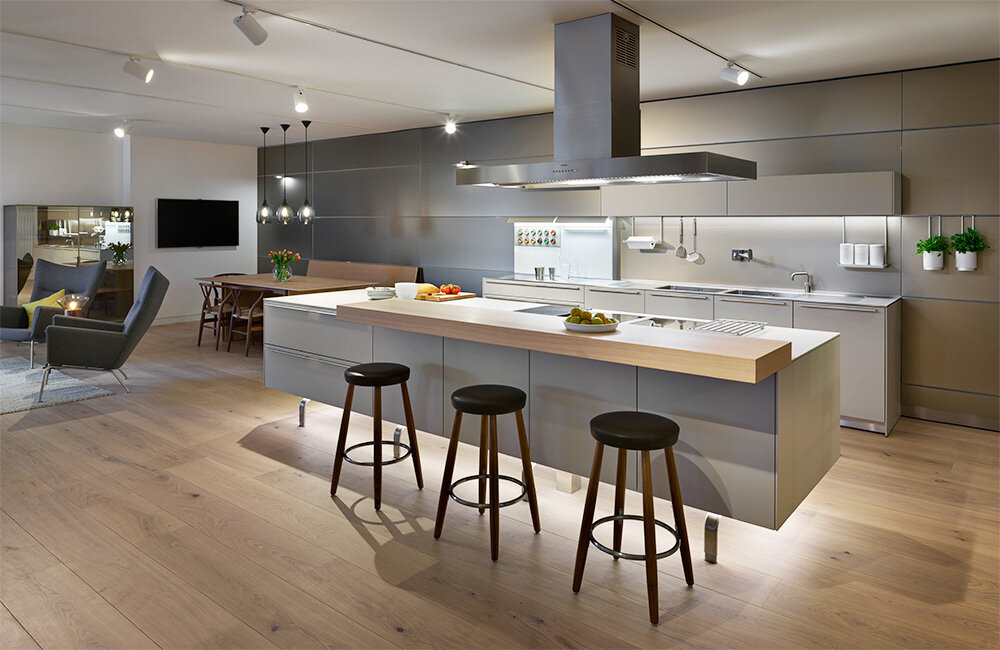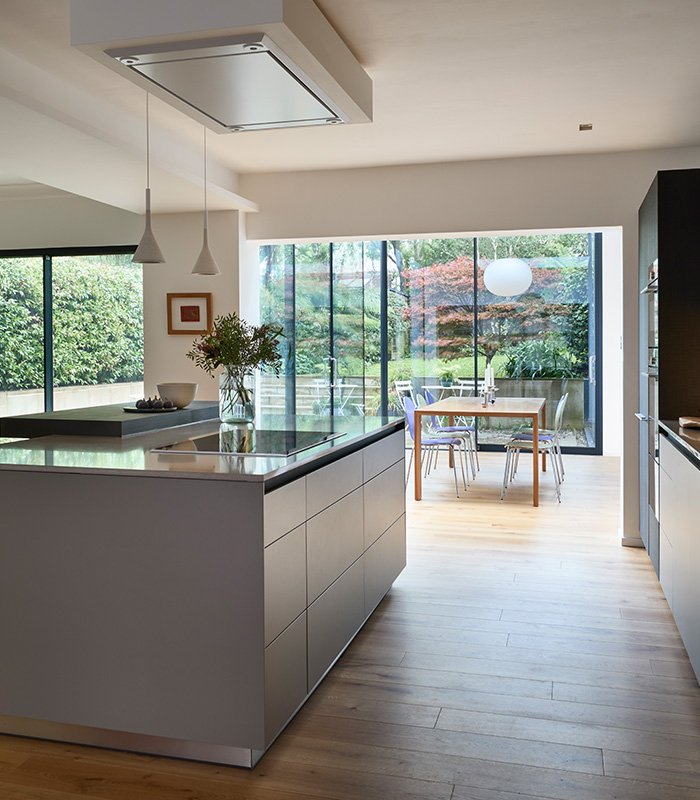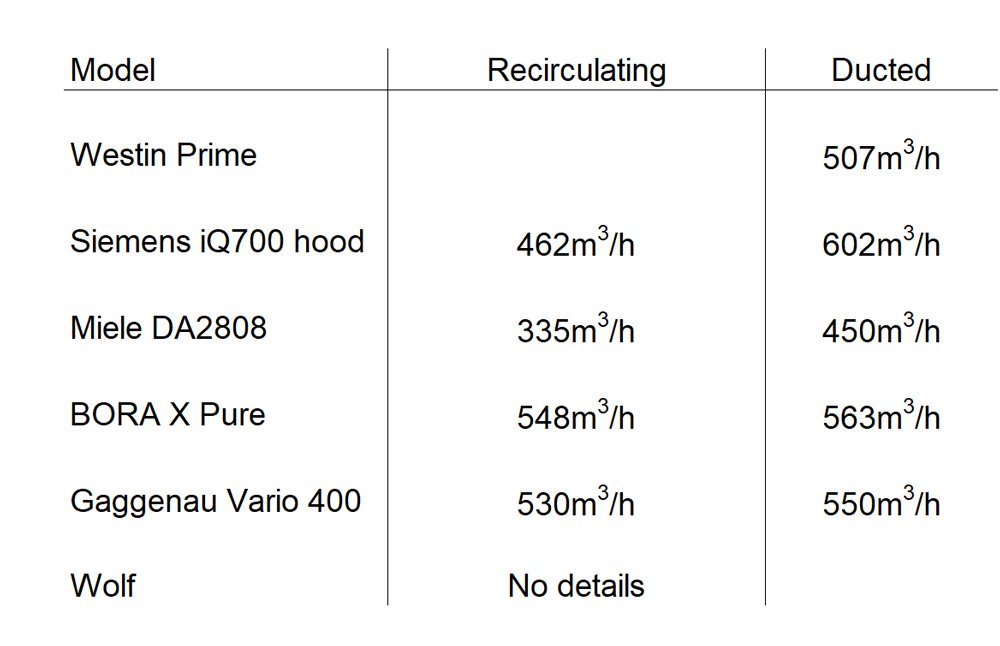Which Kitchen Extractor Fan is Best for my Project?
The basic principle of fluid mechanics that enables downdraft extractor to work is Bernoulli’s principle. Bernoulli’s principle states that as the speed of a fluid increases, its pressure decreases. This principle is used in downdraft extractors to create a low-pressure zone that pulls air down into the extractor.
UP, DOWN, OR ROUND AND ROUND?
Preventing your home from smelling like your last evening meal is one of the primary goals of anyone thinking about a new kitchen extractor. Airbourne grease particles end up on top of wall units, ceilings, etc, leaving an unwanted tacky residue.
Traditionally, this task was the job of an overhead cooker hood, positioned against an external wall and expelling the air directly outside through a vent. Gradually, internal active charcoal cleaning filters improved, capturing and purifying more of the air, negating the need for it to be sent outside. Thus, the recirculating extractor was born and new shapes and design opportunities were made possible.
For a long time, an overhead cooker hood was the most effective method of clearing the air above the hob. Appliance manufacturers, including Gaggenau, Sub-Zero Wolf and Miele, developed downdraft extractors that rose up from the worktop. These monolithic extractors looked impressive, but proved costly and took up useful storage space compared to their overhead counterparts.
BORA revolutionised the downdraft market in 2007 by combining effective extraction and filtration with powerful induction cooking technology in one single space-saving appliance. Since the launch of the BORA downdraft extraction system, Gaggenau, Miele and Siemens, to name but a few, have released their own similar product ranges. However, BORA continues to innovate and use clever ‘Red Bull-esque’ marketing strategies, sponsoring cycling teams and investing in prominent TV advertising, to build the brand and product recognition.
Nowadays, cooking ventilation and the science of extraction has become much more intriguing for clients.
Replenishing the Air in your Home
Building regulations require a certain amount of air changes per hour to ensure water vapour in the air from showers, cooking, and washing doesn’t settle and cause mould. In a kitchen, a ducted extractor will fulfil this. However, a recirculating extractor will not. In this case, you would therefore need a supplementary extraction system – either a dedicated extractor fan in the ceiling or on a wall or, more common in the case of new builds, a whole-house MVHR (mechanical ventilation and heat recovery) system.
More info on the relevant Building Regs can be found in the links below:
https://www.homebuilding.co.uk/advice/building-regulations-part-f
When working on new build projects, we often tend to specify a recirculating extractor with an MVHR. This is a more environmentally friendly option because rather than taking all of that heated air in your house and venting it outside (which then needs to be replenished and reheated) a recirculating system keeps that heated air and sends it back into the room.
Similarly, as new properties are generally fairly airtight, ducting an extractor out can cause problems – you effectively reduce the pressure inside the house as there’s no way of replenishing the air that’s been extracted. To remedy that challenge you would then need an air replenishment system. This is less of an issue for older houses as they’re so full of leaks that air finds its way in.
how do you choose the right extraction method and model for your kitchen?
With recent history aside, how do you choose the right extraction method and model for your kitchen?
Cooker hood
Built-in
Ceiling-mounted
Integrated downdraft
Downdraft extractor
At Hobson’s Choice, we recommend extractors from manufacturers including Westin, Wolf, Gaggenau, Siemens, Miele and BORA. Early on during the design process you will explore one or more of our showrooms and learn about the different types of extractor technology we have on display. You will also see finished projects on our website that utilise different extractor models.
What you eventually choose depends on what you want to achieve in the design of your new kitchen. These criteria can help you define the right choice for you.
What is your appliance budget?
We offer a range of highly functional kitchen appliances, at varying price points, which enable you to specify your new kitchen project with excellent cooking, cooling, cleaning and ventilation technology. You may prefer to have a suite of appliances from a single manufacturer, as this can bring compatibility benefits when the appliances are able to ‘talk’ to one another. Or, you might like to pick different appliances for different tasks, for example, a Teppan Yaki cooktop from Gaggenau and a ceiling extractor from Westin, the choice is yours.
A recirculating ventilation system will likely cost more than the equivalent ducted system due to the additional filtration system required to clean the air. However, removing the additional labour, materials and ducting pipework costs may make recirculating a more attractive option.
These are example prices of popular Hobson’s Choice client extractor choices in ducted and recirculating configurations. We’ve included an estimated allowance of £200 for ducting, this would depend on the property and design. Prices are correct at the time of writing (15.06.2022) and include VAT.
What is the Volume of your Kitchen Space?
Guidance suggests a kitchen extractor should be capable of refreshing the air in the room ten times an hour. The size of this task is calculated by multiplying the length, width and height of the room together, and then multiplying that total by 10. This gives you the cubic volume of air the extractor will move in an hour (m3/h).
If you have a large open plan space, you may wish to consider an extractor with a suitable capacity. The table shows the manufacturer-quoted figures for the extractors featured in this article. The figures quoted are the highest normal setting, not the boosted setting which you would be unlikely to run for elongated periods of time.
Where would you like to position the extractor (over/on an island or on an external wall)?
KITCHEN ISLAND
Cooking on an island and looking into the kitchen/living space can be a very pleasing and desirable design attribute. The layout lends itself to a more social, engaging environment, in which the cook and guests can converse face to face, without the need to turn away.
This layout lends itself to all types of ventilation, although ducting can be more challenging than recirculation due to the channelling required for the pipework – underfloor or within the ceiling.
In addition, if the ducting distance exceeds a certain length, the airflow created by the motor will be too slow to work efficiently. A second ‘remote’ motor would need to be fitted outside to help pull the air through.
Recessed Ceiling - If positioned above the island the extractor can potentially be recessed into the ceiling space or fitted into a purpose-made ‘drop ceiling’.
Cooker Hood – Mounted lower over the cooking surface, a hood enables a shorter, quicker route from the cooktop to the extractor. The shorter distance can potentially reduce the movement of unwanted smells around the room. It does introduce a visual ‘centrepiece/obstruction’, depending on the client's opinion.
Downdraft – Whether integrated within an induction hob or positioned alongside a cooktop module, a downdraft re-circulating extractor will eliminate a portion of the available storage space within the island.
EXTERNAL WALL
The most efficient way of positioning a ducted extractor is on an external wall because it minimises the distance the unwanted air must travel. However, being this definitive can adversely impact a design layout and conflict with the most favourable user experience. In some cases, it simply might be impossible to position an extractor on an external wall due to the architecture of the space.
When faced with this challenge, a recirculating wall-mounted extractor would be a suitable alternative, and capable of being freely positioned.
Is your property Listed or have any restrictions that would cause a problem installing ducting in the floor or ceiling?
In a Listed property, there are often restrictions that can influence extraction opportunities, floors, walls, or ceilings may be covered by the Listed status and not be allowed to be touched or altered - this may also be true in apartment buildings.
Before commencing it is recommended that the parameters of any building are explored to ensure no issues arise later. It would be expected that these questions would be raised by your designer as part of the design process.
Do you want to keep your ceiling and/or walls free from obstruction?
In a minimalist-style kitchen, it can be desirable to keep the walls/ceiling free from obstruction or appear uniform in design. An uncluttered or uniform aesthetic style can increase the sense of space and allow for skylights and characterful details, such as exposed ceiling beams, to be clearly visible.
If this is your design preference, then a downdraft or built-in extractor would be the right choice for you.
Does your kitchen space link directly into an open-plan living area?
In an open-plan space, noise can become a greater contributing factor to the choice of a suitable extractor. Whilst the cook is working other members of the household may be having an online video meeting, trying to watch TV, or enjoying music, all in the same room.
The details below show the manufacturer quoted noise range of each extractor featured in this article, from the lowest to boost settings. As a guide, a normal conversation would be around 60 decibels (Db) and a vacuum cleaner would be 75Db.
Westin Prime (built-in) > 44 to 62Db
Siemens iQ700 hood > no minimum quoted, up to 73Db
Miele DA2808 (ceiling extractor) > 35 to 65 Db
BORA X Pure > 41.2 to 68.6Db
Gaggenau Vario 400 (downdraft) > 56 to 75Db
Wolf stainless steel hood (kitchen island) > No figures to quote
The effectiveness of the extractor at capturing unwanted odours from near the source may also influence the appliance selection. Rather than pulling the smells upwards, offering more of a chance to spread, quickly sucking them downwards could reduce the overall ambient scent.
If the noise was a significant problem, a ducted extractor could be fitted with a remote motor outside of the open-plan space, in the loft for example. By relocating the motor, the noise is greatly reduced, but this is property dependent.
Servicing schedule – filters, costs, timescales
All extractors require a degree of ongoing maintenance to ensure unwanted smells and odours continue to be efficiently removed.
Grease filters need to be cleaned regularly to maintain airflow and odour removal. Appliances recommended by Hobson’s Choice would likely feature a metal grease filter allowing the units to be thoroughly washed in a dishwasher.
In a recirculating extractor, there are active charcoal filters which trap unwanted particles, cleaning the extracted air before allowing it back into the room. The charcoal filters will need replacing by the owner at manufacturer-advised intervals, the table details example costs for recirculating extractors popular with Hobson’s Choice clients.
In Conclusion
In conclusion, the correct choice of ventilation for your kitchen project depends on your property, the design, and your individual style. There are lots of different extractors to choose from, available in different shapes and colours, offering varying functionality across a spectrum of price points.
When you work with us to design your next kitchen, our designers will help you filter the most suitable options into a smaller collection from which to choose your favourite. To find out more about our kitchen design services and the customer journey, click on the button below.









